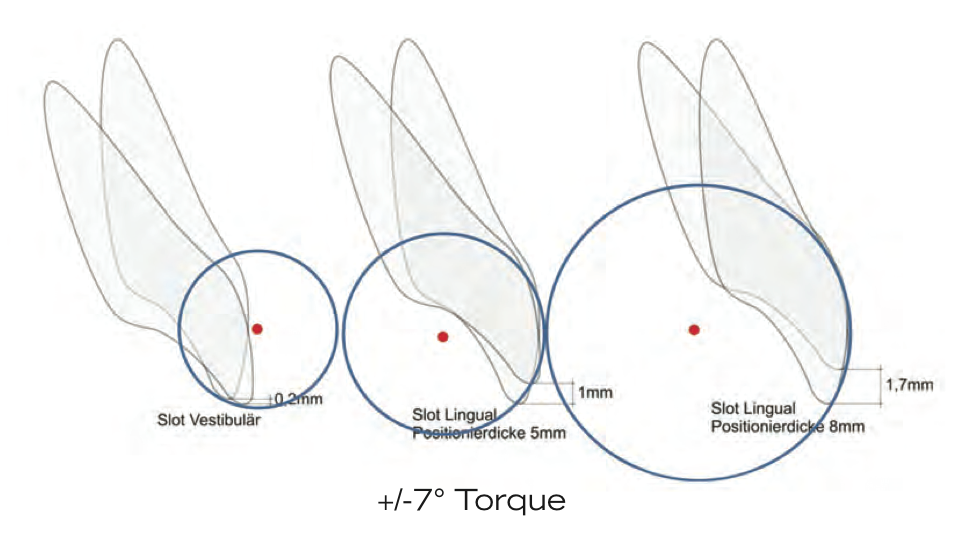
Figure 1: Here is a perfect illustration of how we need to be that much more accurate with lingual. Assuming an average of 14 degrees of torque slop in a noncustomized appliance, the photo on the left shows that if point of force is placed on the labial, it only effects the incisal edge position by .2 mm. However, when placed on the lingual, depending on how close to the lingual surface we can get, the discrepancy can be from 1 mm (center) to almost 2 mm (right).
By Adam Schulhof, DMD
It may have taken 30 years, but lingual orthodontics is finally a truly viable treatment option. For years considered a “fringe” appliance, technology has finally advanced to the point where we can treat any malocclusion with lingual appliances and finish with the same results as classic labial orthodontics.
Why has it taken lingual this long to “catch on”? Most would point to ease of use, or lack there of, as lingual could quite literally be a “pain in the neck.” But really, the main factor to most in the field has been the difficulty of finishing a case to the same standards as labial orthodontics can be done.
It comes down to a biomechanical consideration. As orthodontists, we are trying to effect a change on the facial surface of a tooth. When working with a labial appliance, our point of application is right there directly on that surface. When we have a lingual appliance, we have removed ourselves from that surface and are attempting to exert a force “long distance.” This is magnified as the bulk of the bracket is considered.
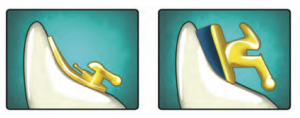
Figure 2: An important consideration will always be how close to the lingual surface of the tooth the bracket slot can be placed. If a custom resin base is required, this will actually bring the wire slot farther from the surface of the tooth.
Imagine for a moment you have a tooth on the end of a long broomstick. A slight movement of your wrist produces a very large movement of the tooth at the end of the broomstick. This is a perfect illustration of how within lingual orthodontics every little micro-movement counts immensely. We must have much more control and specificity when attempting to treat from the lingual.
This is where customization comes into play. Without a truly customized appliance, it is very difficult to finish a patient well, as every little movement is so magnified.
Let’s take torque slop as an example. During non-custom appliance production, there are processes that tumble or polish brackets and produce slots that are not as ideal as we would like. On average, the “slop” between a full-sized archwire and a slot can allow for 14 degrees of torque play. As Figure 1 shows, this 14 degrees, when applied at the facial, will only produce a minor incisal edge discrepancy of .2 mm.
This is not noticeable to a patient and can be alleviated with minor enameloplasty. However, when we consider this same 14 degrees of play but at a point of application from the lingual, this incisal edge discrepancy will be from 1 to almost 2 mm depending on the bulk of the bracket (Figure 1).
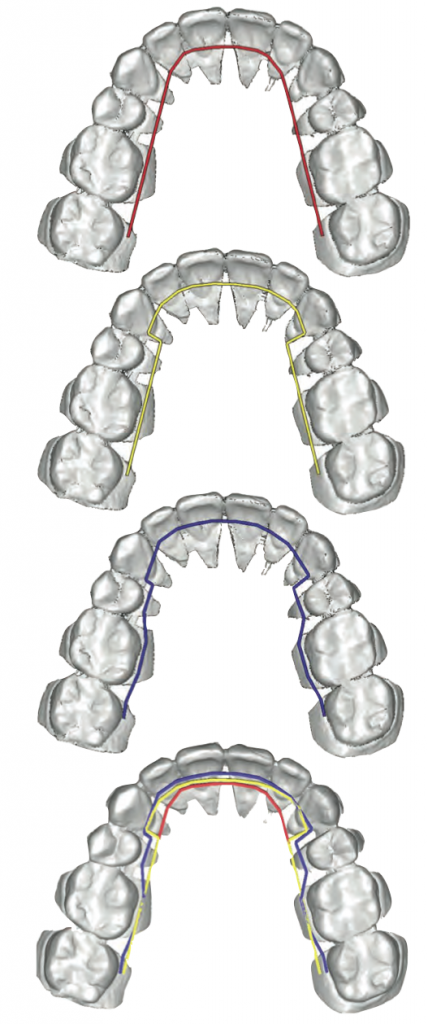
Figure 3: Custom archwires bent toward the individual patient’s anatomy will allow for brackets and slots to be as close to the surface of the tooth as possible.
This highlights two very important factors. The first is, of course, how close to the lingual surface of the tooth we can get the bracket slot. Notice I said “bracket slot.” There are many companies that advertise tiny lingual brackets. Understand, though, that these brackets must be set up to the proper torque and will therefore require custom resin bases, which will actually bring the wire slot even farther from the surface of the tooth (Figure 2).
Another consideration is the archwire and level of customization. Using standard or even mushroom archwires, the slots/brackets have to be built up off the surface of the teeth toward the archwire. Custom archwires bent toward the individual patient’s anatomy will allow for brackets and slots to be as close to the surface of the tooth as possible, allowing for better patient comfort—but even more importantly, less magnification and more control (Figure 3).
The second factor would be the customization of the bracket slot itself. As mentioned, mass-produced brackets (labial and lingual) will have, on average, 14 degrees of torque slop. This is an error we cannot afford during lingual treatment, as it can result in 2 mm of incisor edge control loss. This translates into the need for not only customized pads, but also a customized bracket and slot as well.
These biomechanical considerations point toward the need for a highly customized appliance to obtain great results with lingual orthodontics. The historical stigmas of lingual not finishing well are due to lack of the proper technology. Lingual in the ’80s and ’90s was truly an appliance ahead of its time.
Today, technology has finally caught up and is allowing the customization needed for a truly great lingual system. Gone are the days of, “You’re not a candidate for lingual.” With today’s technology and fully customized lingual appliances such as Incognito™, every patient is a candidate.
The following cases are just a small example of how lingual treatment can run the gamut of malocclusions, and how we can truly treat every patient walking through the door.
Case 1: Relapse
Our first case is the bread and butter of adult orthodontics (Figure 4). The adult patient has had orthodontics as an adolescent but is suffering from relapse. It is important to note that although the crowding is localized to the anteriors mostly, this patient’s chief complaint included “tipped-in back teeth.”
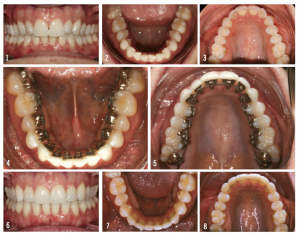
Figure 4: This case showcases an adult patient who had orthodontics as an adolescent, but relapsed. Top images show the patient at the initial visit, with crowding localized to the anteriors mostly. Center images show the patient bonded at midcourse, while the bottom images show the patient after debonding at 12 months.
It was extremely important to control and correct the posterior torque. This was quite a difficult feat with lingual orthodontics until the innovation of customized slots with full-sized “ribbonwise” archwires truly controlling torque, arguably even better than labial edgewise appliances.
The full case was bonded easily using the custom indirect bonding tray. The design of the lower incisor brackets included a “self-retaining slot” behind the incisal wings. These are an amazing innovation, as they allow for increased interbracket distance and thus increased archwire length. It also provides for lower friction and thus efficient initial alignment of the lower incisors.
By the patient’s second visit, we saw crowding resolving. The upper arch was advanced to a .016″ x .022″ NiTi, while in the lower arch we continued to allow the .014″ level and align.
By the patient’s fourth visit, alignment was moving along nicely as we placed the .016″ x .022″ NiTi in the lower arch as well. Here, it is important to note both the rounding out of the arches and the posterior torque and uprighting. At the patient’s fifth appointment, both arches were now in a .017″ x .025″ TMA dialing in final torque and were coordinated beautifully. At the next appointment, to help final settling, we bonded labial composite buttons and had the patient wear triangle elastics for one visit.
Finally, debonding took place at 12 months. As you can see (Figures 4.6 to 4.8), we have obtained not just alignment, but beautiful posterior uprighting. See how nicely we filled out the patient’s smile line. This is more than just giving the patient straight teeth; it’s giving them a “wow” smile.
Case 2: Class II Correction
Correcting Class II malocclusions has also been difficult with lingual orthodontics. Case 2 is an example of a Class II correction using a Forsus appliance in conjunction with Incognito (Figure 5). It highlights how today’s lingual has truly become an appliance as versatile as our classic labial. This patient presents with blocked-out maxillary cuspid, left posterior crossbite, and a Class II molar and canine relationship.
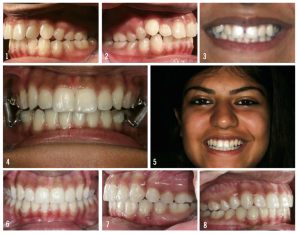
Figure 5: Here, the patient presented with blocked-out maxillary cuspid, left posterior crossbite, and a Class II molar and canine relationship (top images). Images 4 and 5 show a Forsus appliance used in conjunction with Incognito. Note in Image 5 that the Forsus appliance is not visible. The bottom images show the final results.
Treatment planning for a customized appliance starts at design. Incognito is fully customized and allows the orthodontist to choose from an extensive library of auxiliaries. In planning for this case, we built in saddle-type bands (no separation needed) on the maxillary 6’s with TPA sheaths (for the expander, if needed) and buccal tubes (for a Forsus).
After leveling and aligning, we can see a beautiful correction of the deep bite and the left posterior crossbite using just our archwire sequencing in our ribbonwise archwires. At the patient’s sixth appointment, we bonded the lower-arch Forsus attachment. This consisted of a straight length of .017″ x .025″ TMA or steel curled at the ends and bonded to the lower 4’s and 5’s. This, plus the maxillary buccal tube, allowed us to attach a Forsus.
At the next visit, attaching the Forsus was easy as everything had been set up. Notice the facial smiling photo and how the Forsus cannot be seen at all, even when asking the patient to smile as wide as she can (Figure 5.5).
The patient was finally debonded at 19 months with beautiful alignment, arch coordination, and correction of Class II. This case highlights how lingual can now be employed easily, as we can use the same auxiliaries as we do in our everyday labial practice.
Case 3: Extraction and Open Bite
Extraction cases can be difficult regardless of the appliance, and open bites can be particularly challenging. In this case, the patient presents with hyperdivergent full incompetent profile and anterior dental open bite (Figure 6). She reported wanting a correction for years, but was not willing to walk around with braces showing. To alleviate the patient’s concerns, we decided on four bicuspid extractions and Incognito.
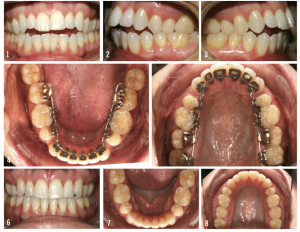
Figure 6: The top images show a patient presenting with hyperdivergent full incompetent profile and anterior dental open bite. The case was bonded prior to referring for extractions. Alignment occurred quickly. With diligent use of elastics, the patient was debonded at 16 months.
We always bond the case and then refer for extractions. The indirect bonding tray is custom. To assure accuracy, we don’t want early extractions to allow drifting of any dentition.
Post extractions, the patient returns for initial .014″ NiTi insertion and pontics bonded off of the 5’s if the patient requests them. Once again, notice the use of the self-retaining wings for lower incisor alignment.
Alignment occurs very quickly, and the next stage of treatment is simply to work through the archwire sequence up to our stainless steel archwire. Retraction and space closure will occur on a .016″ x .024″ stainless steel archwire. To combat the torque “dumping” that occurs with lingual mechanics, we order an additional 13 degrees of slot-filling torque in this archwire. This ensures that as we retract the anterior teeth en masse, we maintain our torque. Once space closure is complete, we asked the patient to wear triangle elastics to help with settling.
The patient did a great job with her elastics, and we debonded at 16 months. This case illustrates how the correct lingual appliance can tackle any malocclusion to the same standards of finishing we expect from our labial appliances, including extraction cases and open bites.
Case 4: Incognito Lite
Incognito Lite is an amazing system that our office rallied for long and hard to bring to market. It has helped so many of our patients achieve the smile of their dreams. At times, the barrier to treatment is financial, and this 3-3 or 4-4 option can make treatment attainable for many. With a noncustomized appliance, these anterior-only options gave us extremely poor results. However, the customization of Incognito affords us the control needed to give our patients amazing results.
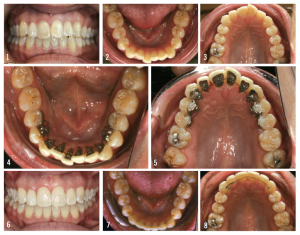
Figure 7: The patient had a history of orthodontic treatment as an adolescent and moderate relapse (top images). She did not want to deal with aligners and refused IPR, thus Incognito Lite was used to treat (center images). The bottom images show the patient at the conclusion of treatment.
This patient presented with a history of orthodontic treatment as an adolescent and moderate relapse (Figure 7). She didn’t want the hassle of taking aligners in and out, and I felt they would never align the lower incisor roots well. She also refused any IPR. We treated her with Incognito Lite, and she was thrilled with the results.
This is treatment that clearly surpasses a labial appliance. Traditional treatment would necessitate full strap-up, as a noncustomized appliance in the anterior would only alter the archform anterior to posterior.
Creating a New Standard
These are just a few examples of how far lingual treatment has come. Having treated hundreds of cases over the course of the last 10 to 12 years, I’d venture to say today’s customized lingual can actually treat cases better than our traditional labial.
The customization and ribbonwise archwire allow for torque control that cannot be obtained with mass-produced labial brackets. While the specificity and exactness can involve a learning curve, once around the bend, as a clinician, it will afford you the ability to “dial in” torques and finishes you’ve never dreamed of.
Yes, lingual has truly come a long way. The right appliance, in the right hands, can not only treat to our high standard of care, but may very well be creating a whole new standard. OP
___________________________________________________________











